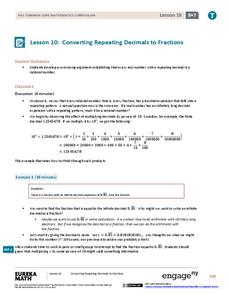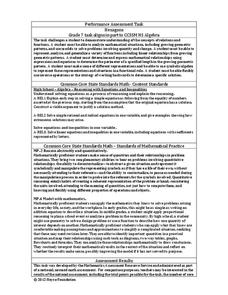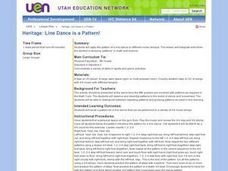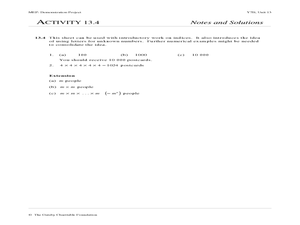K12 Reader
Extending Patterns
2, 4, 6, 8. What comes next? This reading comprehension learning exercise discusses patterns and extending patterns. After reading the short article, kids answer a series of questions to demonstrate their understanding of the passage.
Curated OER
Repeating Digits in Addition
In this patterns worksheet, students solve 4 short answer problems. Students find the pattern of adding the digits one through nine and extend that pattern to natural numbers with the same digit in every place.
EngageNY
Converting Repeating Decimals to Fractions
Develop a process with your classes for converting repeating decimals to fractions. Through this process, pupils understand that any repeating decimal can be written as a fraction. The 10th lesson in this 25-part module helps reinforce...
Curated OER
Patterns
Students explore simple patterns. In this mathematical thinking geometry lesson plan, students repeat clapping and snapping patterns, and determine what comes next in sound and movement patterns. Students recite "Hey, Diddle, Diddle,"...
Curated OER
Introductory Lesson- Patterns
First graders explore patterns in mathematical context. In this patterns lesson plan, 1st graders inspect patterns shown to them, copy patterns, complete patterns and create patterns of their own. These patterns are shown by actions,...
Inside Mathematics
Hexagons
Scholars find a pattern from a geometric sequence and write the formula for extending it. The worksheet includes a table to complete plus four analysis questions. It concludes with instructional implications for the teacher.
Curated OER
Heritage: Line Dance is a Pattern!
Line dancing is the repeating of a pattern of steps, done to music. Teach youngsters how to line dance and they won't feel so awkward when they grow up. Let them experiment with creating their own patterns and teaching their classmates....
Curated OER
Math Series: Number Patterns
The focus of this math lesson is representing numbers in different ways. Young mathematicians practice putting numbers into sets, and arriving at answers in new ways. For example, they are asked to, "Show me how to get 7 eyes." A...
Curated OER
Math Worksheet: Patterns Again
For this math patterns worksheet, students see 10 math patterns with repeating geometric shapes. They choose the shape that will come next in the pattern from 3 choices.
Curated OER
Pattern Block Fractions
Fourth graders participate in a lesson that is about the finding of different fractional sizes with the help of pattern blocks. They define the vocabulary terms of numerator and denominator. The lesson also uses geometry and relates it...
Pennsylvania Department of Education
Extending Pattern Understandings
Students use shapes and manipulatives to demonstrate patterns. In this patterns lesson plan, students also break up patterns to identify a pattern unit.
Education Closet
Equal Rhythms
Engage young mathematicians in learning about fractions with this cross-curricular math and music lesson. After listening to and repeating different beat patterns, children realize that musical notes are just another way of representing...
Curated OER
Repeating and Growing Patterns homework 6.5
In this continuing the pattern worksheet, students observe patterns, write the numbers, draw the next picture, and identify sequence as a repeating pattern or a growing pattern. Students write four answers.
Curated OER
Repeat It challenge
In this recognizing pattern learning exercise, students observe sets of patterns, identify the patterns that repeat, and choose the picture that most likely comes next. Students solve five problems.
Curated OER
Patterns
Fourth graders investigate patterns and sequences. In this patterns and sequences lesson, 4th graders use a hundreds chart to build recurring patterns. Students skip count by threes and fives on a hundreds chart by coloring multiples...
Curated OER
A Matter of Pattern
Students explore how shapes can make patterns then make connections as to how elements in a pattern relate to one another. In this matter of pattern instructional activity, students create a multi-folded paper snowflake. Students engage...
Curated OER
Exploring Number Patterns to Discover Common Factors
Young scholars listen and watch a video to see a drummer beat and find a pattern, while learning about the least common factor. In this lesson, the concept of least common factors is being taught through the use of musical instruments,...
Curated OER
Patterns to the Rescue
Students watch "Cyberchase: The Poddleville Case" and analyze patterns. They complete a patterns assignment worksheet and then they make up patterns using numbers, shapes or colors, for their classmates to solve. They use patterns to...
Curated OER
Hop To It!
Students determine patterns. In this mathematics lesson, students act out a skit, play a sequence game, and complete patterns. Students use problems solving skills.
Curated OER
Introducing Multiplication
Learners will look at repeating addition examples and view how they can be written as multiplication. They use manipulatives to complete a repeating addition lesson and show it on graph paper. They also chart what they have found and...
Curated OER
Strategies for Problem-Solving: Finding Patterns
In this strategies for problem-solving: finding patterns learning exercise, 4th graders use a given pattern to answer 3 questions, then determine another pattern to answer 3 more.
Curated OER
Math Lesson Plan: Bread Bag Tabs: Patterning
Students explore the concept of patterning. In this patterns lesson, students use recycled plastic tab closures as well as their problem solving skills to identify and create patterns.
Curated OER
Searching for Pattern
In these activities with patterns worksheets, students use the rule for 1- or 2- digit number chains, participate in a round robin tournament, identify rhyming patterns and chain letters. Students answer 15 questions.
Math Salamanders Ltd.
Multiplication As Repeated Addition
In this understanding of multiplication as a repeated addition learning exercise, students convert repeated addition facts to multiplication facts and find the products. Students solve 30 problems.

























